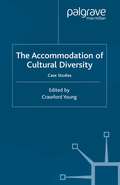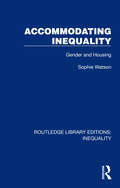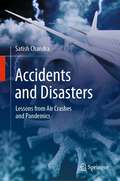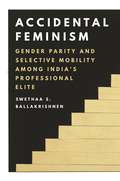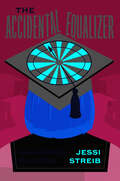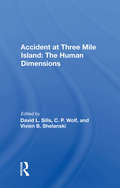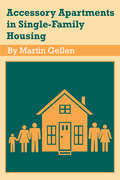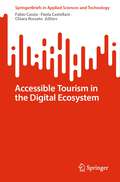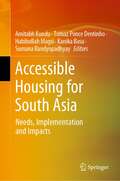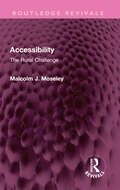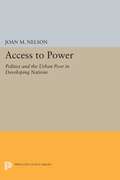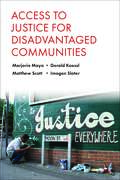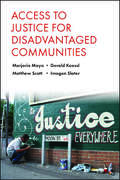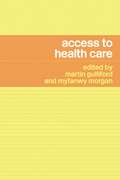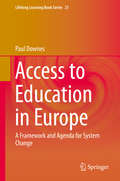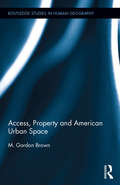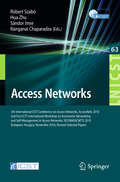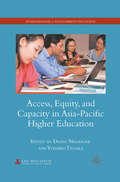- Table View
- List View
The Accommodation of Cultural Diversity: Case-Studies
by Crawford YoungThe management of cultural diversity is a major challenge in many states. This book follows up the theoretical analysis of Ethnic Diversity and Public Policy with detailed case studies from leading international experts on Malaysia, Tanzania, Mauritius, Trinidad and Tobago, Northern Ireland, Spain and the United States of America to discover what lessons can be learnt for policy-makers in other divided societies.
Accommodating Inequality: Gender and Housing (Routledge Library Editions: Inequality #9)
by Sophie WatsonOriginally published in 1988, Accommodating Inequality provides a basis for a radical re-think of housing policy and provision in Australia from a gender perspective. It explores the way that housing in Australia helped to produce patriarchal family structures and simultaneously contributed to the dependence of women on men. At the time the book was originally published housing policy at a theoretical or research level was less explored. Issues such as marginalisation, poverty and low income, domestic responsibility are discussed in relation to housing. The book raised new questions and challenged old debates and provides a clear framework within which feminist housing policy can be situated.
Accommodating Inequality: Gender and Housing (Routledge Library Editions: Inequality #9)
by Sophie WatsonOriginally published in 1988, Accommodating Inequality provides a basis for a radical re-think of housing policy and provision in Australia from a gender perspective. It explores the way that housing in Australia helped to produce patriarchal family structures and simultaneously contributed to the dependence of women on men. At the time the book was originally published housing policy at a theoretical or research level was less explored. Issues such as marginalisation, poverty and low income, domestic responsibility are discussed in relation to housing. The book raised new questions and challenged old debates and provides a clear framework within which feminist housing policy can be situated.
Accidents and Disasters: Lessons from Air Crashes and Pandemics
by Satish ChandraThis book deals with the contemporary subject of perception of risk and its influence on accidents and disasters. The contents examine the conventional viewpoints on human errors, incubation of errors, complexity and organisational deviance as a cause for accidents. Work of Mary Douglas with regard to risk, Charles Perrow's work on the normal accident theory and Diane Vaughan's theory on normalisation of deviance are examined from a fresh perspective in this book. It also discusses prominent accidents in aviation, space, nuclear energy, automotive and healthcare, using the pandemic and Boeing 737 Max as a backdrop to study accidents and disasters. It further explores the background and similarities to these events and addresses the core issues such as the state of regulation, the worldview of the sociologists, and proposes that mental models of complex systems, avarice and risk for gain as other possibilities for accidents. Using the concept of nudge in behavioural economics and the Elinor Ostrom’s viewpoint on regulating for common good, it suggests a way forward through the High Reliability Organisation Theory (HRO) leading to enhanced risk perception. The book will be of interest to those who would like to understand the need to incorporate risk perception into regulation, engineers and scientists, professionals and policy makers working in the areas of disaster and risk management, technology areas like aviation, nuclear plants, space and healthcare, students of the sociology of risk and of course the general reader.
Accidental Feminism: Gender Parity and Selective Mobility among India’s Professional Elite
by Swethaa S. BallakrishnenExploring the unintentional production of seemingly feminist outcomes In India, elite law firms offer a surprising oasis for women within a hostile, predominantly male industry. Less than 10 percent of the country’s lawyers are female, but women in the most prestigious firms are significantly represented both at entry and partnership. Elite workspaces are notorious for being unfriendly to new actors, so what allows for aberration in certain workspaces?Drawing from observations and interviews with more than 130 elite professionals, Accidental Feminism examines how a range of underlying mechanisms—gendered socialization and essentialism, family structures and dynamics, and firm and regulatory histories—afford certain professionals egalitarian outcomes that are not available to their local and global peers. Juxtaposing findings on the legal profession with those on elite consulting firms, Swethaa Ballakrishnen reveals that parity arises not from a commitment to create feminist organizations, but from structural factors that incidentally come together to do gender differently. Simultaneously, their research offers notes of caution: while conditional convergence may create equality in ways that more targeted endeavors fail to achieve, “accidental” developments are hard to replicate, and are, in this case, buttressed by embedded inequalities. Ballakrishnen examines whether gender parity produced without institutional sanction should still be considered feminist.In offering new ways to think about equality movements and outcomes, Accidental Feminism forces readers to critically consider the work of intention in progress narratives.
The Accidental Equalizer: How Luck Determines Pay after College
by Jessi StreibA startling discovery—that job market success after college is largely random—forces a reappraisal of education, opportunity, and the American dream. As a gateway to economic opportunity, a college degree is viewed by many as America’s great equalizer. And it’s true: wealthier, more connected, and seemingly better-qualified students earn exactly the same pay as their less privileged peers. Yet, the reasons why may have little to do with bootstraps or self-improvement—it might just be dumb luck. That’s what sociologist Jessi Streib proposes in The Accidental Equalizer, a conclusion she reaches after interviewing dozens of hiring agents and job-seeking graduates. Streib finds that luck shapes the hiring process from start to finish in a way that limits class privilege in the job market. Employers hide information about how to get ahead and force students to guess which jobs pay the most and how best to obtain them. Without clear routes to success, graduates from all class backgrounds face the same odds at high pay. The Accidental Equalizer is a frank appraisal of how this “luckocracy” works and its implications for the future of higher education and the middle class. Although this system is far from eliminating American inequality, Streib shows that it may just be the best opportunity structure we have—for better and for worse.
The Accidental Equalizer: How Luck Determines Pay after College
by Jessi StreibA startling discovery—that job market success after college is largely random—forces a reappraisal of education, opportunity, and the American dream. As a gateway to economic opportunity, a college degree is viewed by many as America’s great equalizer. And it’s true: wealthier, more connected, and seemingly better-qualified students earn exactly the same pay as their less privileged peers. Yet, the reasons why may have little to do with bootstraps or self-improvement—it might just be dumb luck. That’s what sociologist Jessi Streib proposes in The Accidental Equalizer, a conclusion she reaches after interviewing dozens of hiring agents and job-seeking graduates. Streib finds that luck shapes the hiring process from start to finish in a way that limits class privilege in the job market. Employers hide information about how to get ahead and force students to guess which jobs pay the most and how best to obtain them. Without clear routes to success, graduates from all class backgrounds face the same odds at high pay. The Accidental Equalizer is a frank appraisal of how this “luckocracy” works and its implications for the future of higher education and the middle class. Although this system is far from eliminating American inequality, Streib shows that it may just be the best opportunity structure we have—for better and for worse.
Accident At Three Mile Island: The Human Dimensions
by David L. SillsThe nuclear accident at Three Mile Island in March 1979 was as much a social-systems failure as it was an engineering failure. It raised questions not only about the regulation and management of nuclear-power plants but also about the effects of nuclear accidents on the community, on society, and on the total controversy surrounding nuclear energy. Questions were also raised about public perceptions of the risks of high technology. At the request of the President's Commission on the Accident at Three Mile Island (the Kemeny Commission), the Social Science Research Council commissioned social scientists to write a series of papers on the human dimensions of the event. This volume includes those papers, in revised and expanded form, and a comprehensive bibliography of published and unpublished social science research on the accident and its aftermath.
Accident At Three Mile Island: The Human Dimensions
by David L. Sills C. P. Wolf Vivien B. ShelanskiThe nuclear accident at Three Mile Island in March 1979 was as much a social-systems failure as it was an engineering failure. It raised questions not only about the regulation and management of nuclear-power plants but also about the effects of nuclear accidents on the community, on society, and on the total controversy surrounding nuclear energy. Questions were also raised about public perceptions of the risks of high technology. At the request of the President's Commission on the Accident at Three Mile Island (the Kemeny Commission), the Social Science Research Council commissioned social scientists to write a series of papers on the human dimensions of the event. This volume includes those papers, in revised and expanded form, and a comprehensive bibliography of published and unpublished social science research on the accident and its aftermath.
Accessory Apartments in Single-family Housing
by Martin GellenAs the reproduction cost of housing has increased, consumers have made intensive use of existing dwellings. Conversions of the housing stock have regained prominence as a source of supply. This book introduces the accessory apartment and assesses its potential as an emerging resource for meeting local and national housing needs. Although accessory apartments help meet some of the nation's housing needs, they are not entirely without problems. Some of these are environmental problems, such as physical alterations that are out of character with the design and appearance of surrounding structures, while other problems are cultural and ideological. The accessory apartment in a single-family house deviates from the image of housing, family, and neighborhood that prevails in American culture. It symbolizes a change in the way the single-family house is used and the kinds of people who live in it. These changes clash with the traditional meanings attached to the categories of residential zoning. Martin Gellen evaluates and answers the following questions throughout the text: How do we live with accessory apartments? Control their number? Ensure their soundness?--and maintain neighborhood standards? He focuses on the physical planning problems of conversions and examines the zoning issues they raise. This includes a realistic appraisal of the purposes of density and occupancy controls in exclusive single-family districts. The author provides new methods for regulation of density and occupancy which permit more flexible use of single-family housing to meet the housing needs of a more diverse population. Whether in an aging suburb or new tract, the accessory apartment is a current challenge. This book provides a clear headed approach toward a popular trend in the ever changing housing industry.
Accessory Apartments in Single-family Housing
by Martin GellenAs the reproduction cost of housing has increased, consumers have made intensive use of existing dwellings. Conversions of the housing stock have regained prominence as a source of supply. This book introduces the accessory apartment and assesses its potential as an emerging resource for meeting local and national housing needs. Although accessory apartments help meet some of the nation's housing needs, they are not entirely without problems. Some of these are environmental problems, such as physical alterations that are out of character with the design and appearance of surrounding structures, while other problems are cultural and ideological. The accessory apartment in a single-family house deviates from the image of housing, family, and neighborhood that prevails in American culture. It symbolizes a change in the way the single-family house is used and the kinds of people who live in it. These changes clash with the traditional meanings attached to the categories of residential zoning. Martin Gellen evaluates and answers the following questions throughout the text: How do we live with accessory apartments? Control their number? Ensure their soundness?--and maintain neighborhood standards? He focuses on the physical planning problems of conversions and examines the zoning issues they raise. This includes a realistic appraisal of the purposes of density and occupancy controls in exclusive single-family districts. The author provides new methods for regulation of density and occupancy which permit more flexible use of single-family housing to meet the housing needs of a more diverse population. Whether in an aging suburb or new tract, the accessory apartment is a current challenge. This book provides a clear headed approach toward a popular trend in the ever changing housing industry.
Accessible Tourism in the Digital Ecosystem (SpringerBriefs in Applied Sciences and Technology)
by Fabio Cassia Paola Castellani Chiara RossatoThis book explores the growing demand for accessible tourism experiences and demonstrates how the perspective of digital ecosystems can play a vital role in creating more inclusive destinations. Through a combination of conceptual arguments and real-world case studies, the book sheds light on the practical aspects of accessible tourism. Statistics reveal that over one billion people have severe or moderate disabilities, emphasizing the urgent need for enhanced accessibility in tourism. However, both industry practices and academic research in this field are still lagging behind. The book highlights the challenge of establishing coordination among various stakeholders, including transport operators, hospitality firms, and public authorities, which has hindered the design and implementation of inclusive tourism experiences. By harnessing the power of new technologies, the book illustrates how digital ecosystems can effectively facilitate accessible tourism. It examines the demand for such experiences and demonstrates how embracing a digital ecosystem perspective can contribute to the development of more accessible tourism destinations. In addition to its theoretical insights, the book delves into several practical case studies that showcase successful examples of accessible tourism.
Accessible Housing for South Asia: Needs, Implementation and Impacts
by Amitabh Kundu Tomaz Ponce Dentinho Habibullah Magsi Kanika Basu Sumana BandyopadhyayThis book deals with important issues related to urban housing in South Asia. It analyses various aspects of housing, including spatial and temporal requirements and needs, as well as the challenges of implementing housing projects, such as financial feasibility of estate development projects and housing design. Finally, it discusses the socio-economic and environmental impacts of the rapid urban housing development in South Asia. Written by experts from various disciplines, the book presents several case studies that address issues such as housing provision; legislative, financial and technical support; access to employment opportunities and markets; the cumulative impact on gentrification; exclusion and spatial equity; and the economic, social and environmental sustainability of urban tissue. Researchers, housing planners, and policy makers will find this book a valuable resource in meeting the demand for affordable and sustainable housing and overcoming housing shortages in developing countries
Accessibility: The Rural Challenge (Routledge Revivals)
by Malcolm J. MoseleyOriginally published in 1979, this book discusses the problem faced by planners, county councils, transport, health and education authorities as well as the inhabitants of rural Britain, of the inaccessibility of many areas of the UK. For certain sections of society such as the less well-off, children and teenagers and the elderly the impact is felt most strongly when local shops, schools and medical services are withdrawn in favour of larger units in distant towns. The book reviews the process of decline which led to this situation and considers the concept of accessibility to show how it can be developed into an analytical tool for measuring the success or failure of alternative policies. Each policy option is discussed in detail: the support of conventional bus or other transport services; the provision of mobile services; ‘mini-outlet’ policies and the long-term restructuring of the rural settlement pattern.
Accessibility: The Rural Challenge (Routledge Revivals)
by Malcolm J. MoseleyOriginally published in 1979, this book discusses the problem faced by planners, county councils, transport, health and education authorities as well as the inhabitants of rural Britain, of the inaccessibility of many areas of the UK. For certain sections of society such as the less well-off, children and teenagers and the elderly the impact is felt most strongly when local shops, schools and medical services are withdrawn in favour of larger units in distant towns. The book reviews the process of decline which led to this situation and considers the concept of accessibility to show how it can be developed into an analytical tool for measuring the success or failure of alternative policies. Each policy option is discussed in detail: the support of conventional bus or other transport services; the provision of mobile services; ‘mini-outlet’ policies and the long-term restructuring of the rural settlement pattern.
Access to Power: Politics and the Urban Poor in Developing Nations (PDF)
by Joan M. NelsonJoan Nelson elucidates the implications of this rapid growth and concomitant poverty for politics. Unlike many scholars who have sought an all-encompassing theory to explain the political behavior of the urban poor, Professor Nelson emphasizes the complex variety in the economic, social, and political circumstances that influence this behavior.Originally published in 1979.The Princeton Legacy Library uses the latest print-on-demand technology to again make available previously out-of-print books from the distinguished backlist of Princeton University Press. These editions preserve the original texts of these important books while presenting them in durable paperback and hardcover editions. The goal of the Princeton Legacy Library is to vastly increase access to the rich scholarly heritage found in the thousands of books published by Princeton University Press since its founding in 1905.
Access to justice for disadvantaged communities
by Marjorie MayoAccess to justice for all, regardless of the ability to pay, has been a core democratic value. But this basic human right has come under threat through wider processes of restructuring, with an increasingly market-led approach to the provision of welfare. Professionals and volunteers in Law Centres in Britain are struggling to provide legal advice and access to welfare rights to disadvantaged communities. Drawing upon original research, this unique study explores how strategies to safeguard these vital services might be developed in ways that strengthen rather than undermine the basic ethics and principles of public service provision. The book explores how such strategies might strengthen the position of those who provide, as well as those who need, public services, and ways to empower communities to work more effectively with professionals and progressive organisations in the pursuit of rights and social justice agendas more widely.
Access to justice for disadvantaged communities
by Marjorie MayoAccess to justice for all, regardless of the ability to pay, has been a core democratic value. But this basic human right has come under threat through wider processes of restructuring, with an increasingly market-led approach to the provision of welfare. Professionals and volunteers in Law Centres in Britain are struggling to provide legal advice and access to welfare rights to disadvantaged communities. Drawing upon original research, this unique study explores how strategies to safeguard these vital services might be developed in ways that strengthen rather than undermine the basic ethics and principles of public service provision. The book explores how such strategies might strengthen the position of those who provide, as well as those who need, public services, and ways to empower communities to work more effectively with professionals and progressive organisations in the pursuit of rights and social justice agendas more widely.
Access to Health Care
by Martin Gulliford Myfanwy MorganTo what extent can we have truly universal, comprehensive and timely health services, equally available to all? Access to Health Care considers the meaning of 'access' in health care and examines the theoretical issues that underpin these questions. Contributors draw on a range of disciplinary perspectives to investigate key aspects of access, including:· geographical accessibility of services· socio-economic equity of access· patients' help-seeking behaviour· organisational problems and access· methods for evaluating access.Access is considered in both a UK and international context. The book includes chapters on contrasting health policies in the United States and European Union. Access to Health Care provides both health care researchers as well as health professionals, managers and policy analysts, with a clear and wide-ranging overview of topical and controversial questions in health policy and health services organization and delivery.
Access to Health Care
by Martin Gulliford Myfanwy MorganTo what extent can we have truly universal, comprehensive and timely health services, equally available to all? Access to Health Care considers the meaning of 'access' in health care and examines the theoretical issues that underpin these questions. Contributors draw on a range of disciplinary perspectives to investigate key aspects of access, including:· geographical accessibility of services· socio-economic equity of access· patients' help-seeking behaviour· organisational problems and access· methods for evaluating access.Access is considered in both a UK and international context. The book includes chapters on contrasting health policies in the United States and European Union. Access to Health Care provides both health care researchers as well as health professionals, managers and policy analysts, with a clear and wide-ranging overview of topical and controversial questions in health policy and health services organization and delivery.
Access to Education in Europe: A Framework and Agenda for System Change (Lifelong Learning Book Series #21)
by Paul DownesThis book identifies key elements of an international framework to develop systems-level change to promote access to education, including higher education, for socio-economically marginalized groups. It is based on interviews with senior government officials and senior management in universities, non formal education and prisons across 12 countries in Europe. The book identifies systemic obstacles to and opportunities for promotion of access to education for socio-economically excluded groups that are issues transferable to other countries’ contexts. It adopts a systemic focus on access across a range of domains of education, both formal higher education and non-formal education, as well as prison education. Through a focus on a more dynamic structuralist systems framework it develops an innovative post-Bronfenbrennerian view of system levels in lifespan developmental and educational psychology. It also develops an international agenda for reform in relation to these various system levels for access to education for socio-economically marginalized groups, through extraction of key structural indicators to evaluate reform progress in a transparent, culturally sensitive manner. The book identifies current gaps and strengths in policy, practice and structures that impact upon access to education, including higher education, across a range of countries. These gaps and strengths are illustrative and are to inform a strategic approach to system level change and development for the promotion of access to education for socio-economically marginalized groups in Europe and beyond.“Too many educational practices entrench social exclusion: it is an urgent priority across Europe that social justice policies are implemented for the inclusion of marginalised groups. Paul Downes' analysis of these issues is timely. His conclusions are considered and practical: this book is a valuable and constructive resource for practitioners, academics and the policy community.” Professor Alistair Ross, Jean Monnet ad Personam Professor of Citizenship Education in Europe, Emeritus Professor of Education, Institute for Policy Studies in Education, London Metropolitan University
Access, Property and American Urban Space (Routledge Studies in Human Geography)
by M. Gordon BrownThis book explains why the earliest cities had grid-form street systems, what conditions led to their being overwhelmingly preferred for 5000 years throughout the world, why the Founding Fathers wanted gridform cities and how they affect economic transactions. Real property has been instrumental in forming urban settlements for 5000 years, but virtually all urban form commentary, theory and research has ignored this reality. The result is an incomplete and flawed understanding of cities. Real property became a means of arranging spatial patterns caused by millennia of human evolutionary and historical developments with respect to access and movement. As a result, access to resources of all types became a regulatory mechanism controlled, at least in part, by real property ownership. The effects of real property on urban spatial patterns are currently best seen by examining American urban space, which has changed significantly over the past 200 years. This change, which began in the 1840s and established path dependence through a combination of design thought, sentimental pastoralism and financial prowess resulted in an urban regime shift that diminished economic resilience. This book offers a rethinking of how real property relates to real space, examines the thought of form promoters, links space, property, neurological evolution and settlement form, shows access is measurable and describes the plusses and minuses of functionalism, rent seeking, general purpose technology, grid-form street systems and what the American Founding Fathers thought about urban form.
Access, Property and American Urban Space (Routledge Studies in Human Geography)
by M. Gordon BrownThis book explains why the earliest cities had grid-form street systems, what conditions led to their being overwhelmingly preferred for 5000 years throughout the world, why the Founding Fathers wanted gridform cities and how they affect economic transactions. Real property has been instrumental in forming urban settlements for 5000 years, but virtually all urban form commentary, theory and research has ignored this reality. The result is an incomplete and flawed understanding of cities. Real property became a means of arranging spatial patterns caused by millennia of human evolutionary and historical developments with respect to access and movement. As a result, access to resources of all types became a regulatory mechanism controlled, at least in part, by real property ownership. The effects of real property on urban spatial patterns are currently best seen by examining American urban space, which has changed significantly over the past 200 years. This change, which began in the 1840s and established path dependence through a combination of design thought, sentimental pastoralism and financial prowess resulted in an urban regime shift that diminished economic resilience. This book offers a rethinking of how real property relates to real space, examines the thought of form promoters, links space, property, neurological evolution and settlement form, shows access is measurable and describes the plusses and minuses of functionalism, rent seeking, general purpose technology, grid-form street systems and what the American Founding Fathers thought about urban form.
Access Networks: 5th International ICST Conference on Access Networks, AccessNets 2010 and First International Workshop on Automatic Networking and Self-Management in Access Networks, SELFMAGICNETS 2010, Revised Selected Papers, Budapest, Hungary, November 3-5, 2010 (Lecture Notes of the Institute for Computer Sciences, Social Informatics and Telecommunications Engineering #63)
by Hua Zhu Sándor Imre Ranganai Chaparadza Robert SzabóThis book constitutes the reviewed post-proceedings of the 5th International ICST Conference on Access Networks, AccessNets 2010, and of the satellite event , the First International ICST Workshop on Autonomic Networking and Self-Management in Access Networks, SELFMAGICNETS 2010, held jointly in Budapest, Hungary in November 2010. The 19 revised full papers presented together with one invited paper and four poster papers were carefully reviewed and selected for inclusion in the proceedings. The papers are organized in topical sections on next generation wireless networks, emerging applications, next-generation broadband networks and autonomic networking and network self-management.
Access, Equity, and Capacity in Asia-Pacific Higher Education (International and Development Education)
by Deane Neubauer & Yoshiro TanakaHigher education is growing most rapidly in the Asia-Pacific region, and policy makers are facing the task of balancing quality and quantity. This book will help readers understand the current situation of higher education not only in this region but everywhere that they may work.' - Shinichi Yamamoto, Hiroshima University, Japan
